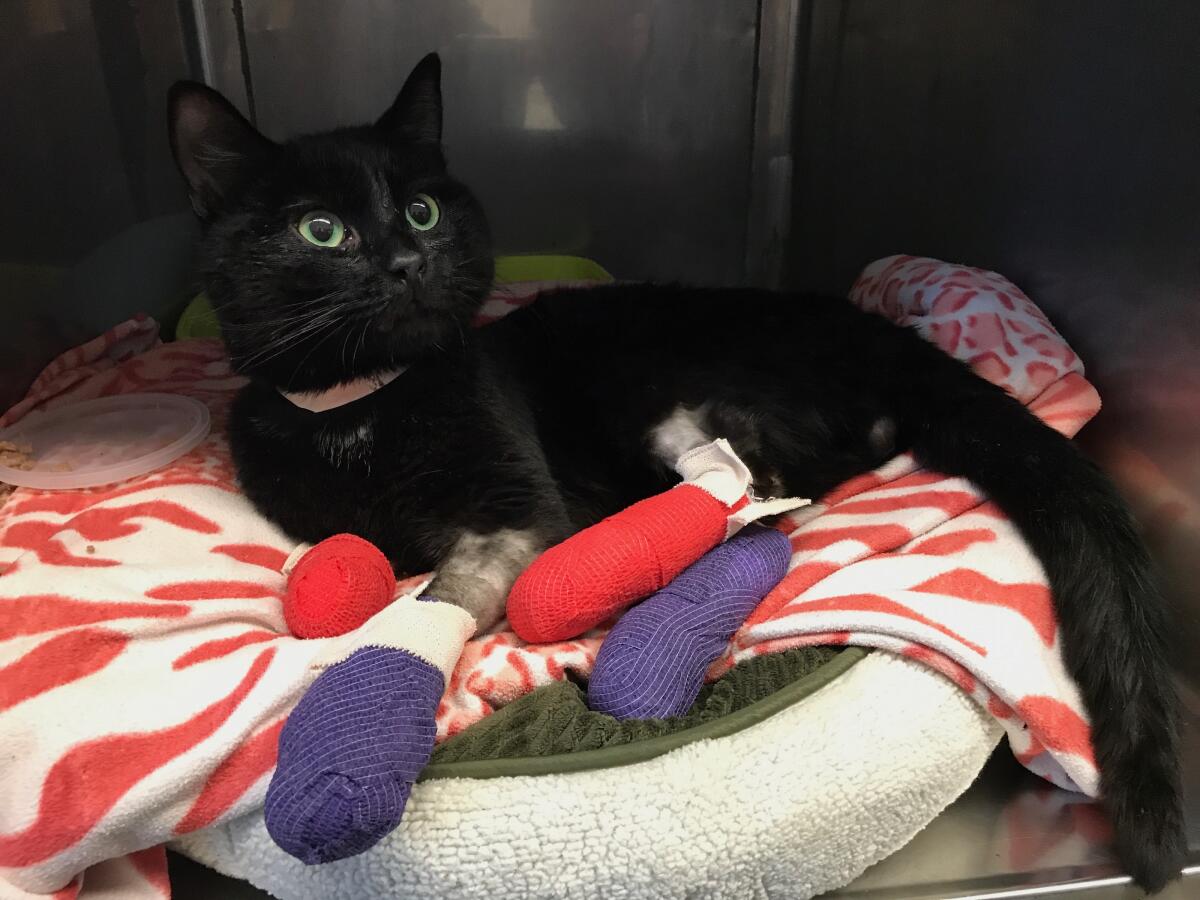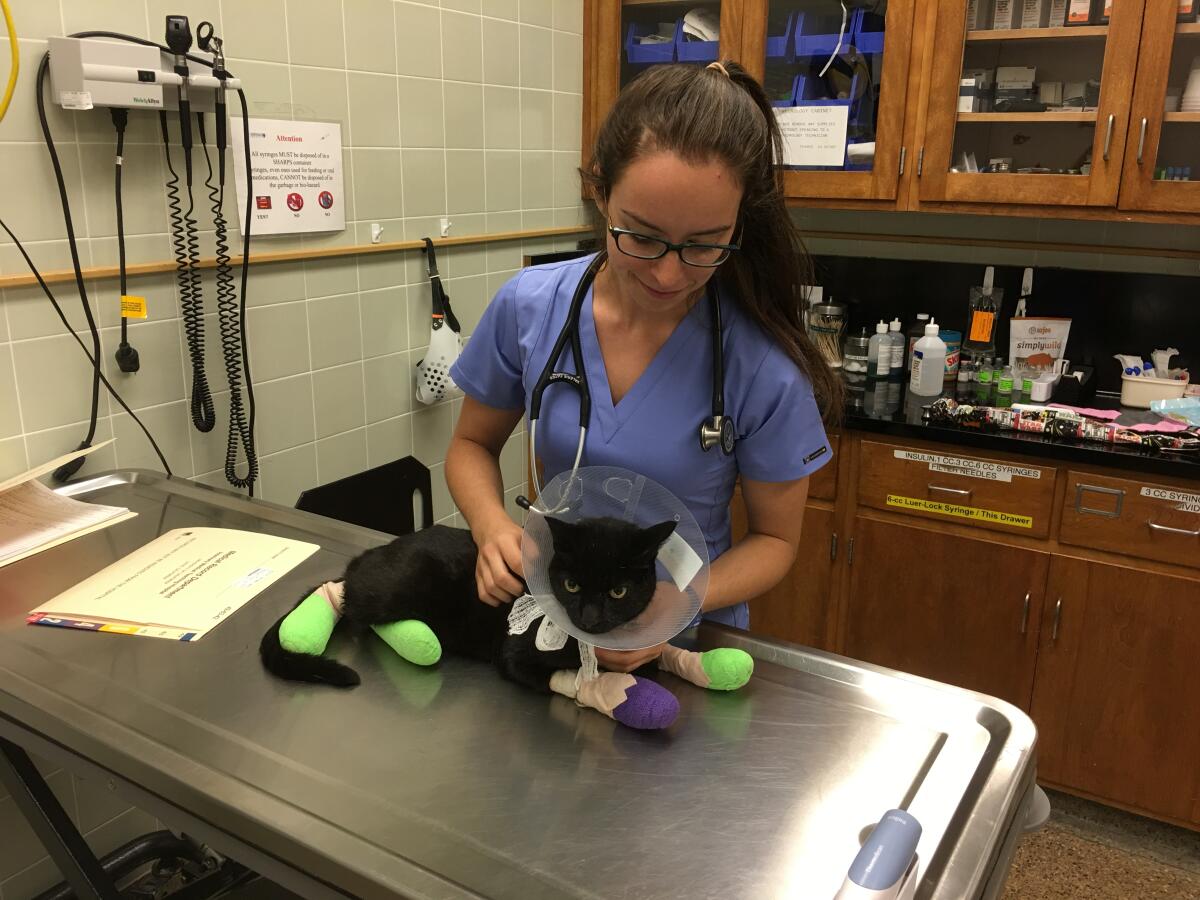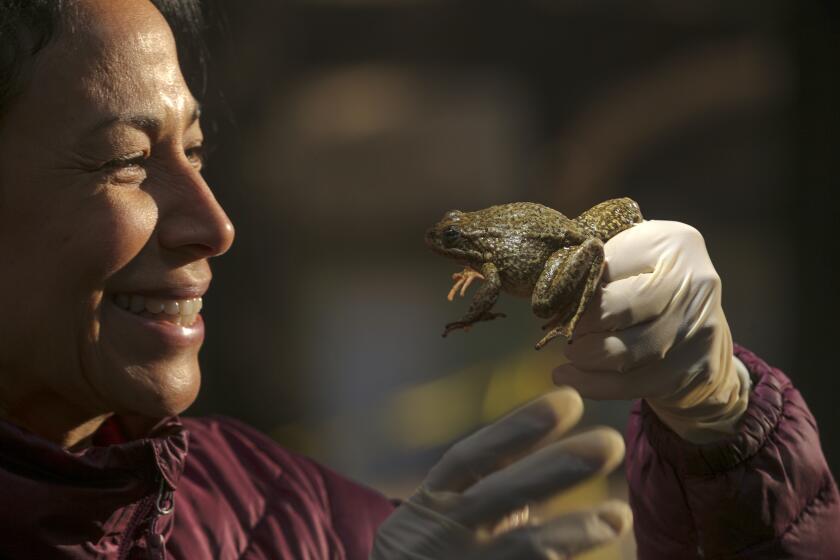Smoke from California wildfires puts cats at risk of developing deadly blood clots

- Share via
Dr. Ronald Li, a critical care veterinarian at UC Davis, treated 23 cats that were rescued from the devastating Tubbs fire that scorched Northern California for more than three weeks in October 2017. They had the kinds of traumatic injuries he expected to see: first- to third-degree burns, exposed skin and scar tissue.
But there was something else about these feline patients that caught Li’s attention: life-threatening blood clots.
“In heart scans, we noticed clots forming within their hearts,” he said. “But at that time, we didn’t know why.”
Blood clots normally develop in response to an injury such as a cut or wound to prevent runaway blood loss. Those weren’t the kinds of problems the cats were dealing with.
So a year later, when the Camp fire ravaged 240 square miles east of Chico, Li collected blood samples from rescued cats that were brought to his clinic.
The researchers found that compared with healthy cats, the cats affected by the wildfire were more likely to have blood clots, which have the potential to be life-threatening. The rescued animals also had more blood clots than a group of cats with a relatively common type of heart disease that increases their risk of clots.
This year’s fires were deadly for both humans and wildlife. Thanks to veterinary care, a raccoon is returning to Orange County, while a trio of mountain lions will move to an Ohio zoo.
The findings, published this month in the journal Frontiers in Veterinary Medicine, mirror an earlier study by UC Davis researchers showing that cats that got close enough to wildfires to be burned or inhale dangerous amounts of smoke were more likely to develop cardiovascular problems, such as a thickening of the heart muscle that can lead to heart failure.
“The results are pretty compelling,” said Bruce Kornreich, director of the Cornell Feline Health Center, who was not involved in the research. “There’s a lot of conserved biology across different species. This is something that could provide information to benefit not only animals but people.”
The new analysis was based on blood samples from 29 cats that were injured in the Camp fire and brought to UC Davis with burns, lung damage and heart issues. They were compared with 11 cats that were perfectly healthy and 21 that were in generally good health but had a type of heart disease called hypertrophic cardiomyopathy.

)
The researchers found that the cats exposed to the Camp fire had highly activated platelets, but the two other groups did not.
Platelets circulate in the bloodstream, usually shaped like tiny disks. But when an injury occurs, the nearby platelets become activated and grow tentacles that clasp one another to form a blood clot. It’s their primary role in the body; activated platelets form barriers that prevent blood loss from a cut or a wound.
The cats rescued from the wildfire didn’t have those kinds of injuries, but their platelets were clotting anyway in the following days. These clots had the potential to restrict blood flow and cause severe disabilities. For instance, blood clots in limbs may induce paralysis, while clots blocking the flow of oxygen to the brain are capable of causing a stroke.
Cats with hypertrophic cardiomyopathy also tend to form clots. But the platelet activity in the rescued cats was up to twice as high as it was in the cats with the heart condition. And compared with the healthy cats, it was about four times as high.
Li and his colleagues also found that the cats exposed to the Camp fire had higher levels of platelet priming than their counterparts in the two other groups. Primed platelets, even in their normal state, are particularly susceptible to being driven straight into the overactive mode.
The nearly 1-million-acre blaze swept through vast swaths of the elusive foxes’ stomping grounds during the summer.
There is hope for cats exposed to wildfires. The researchers found that aspirin, commonly used as a blood thinner in humans and sometimes in cats, was able to stop platelets from clotting.
Kornreich noted that the study involved a relatively small number of cats, but said the result is scientifically important because it stemmed from real-world wildfire conditions.
“The most impactful thing about this paper from a veterinary standpoint is to be knowledgeable of the risks posed to cats by these fires, and to be on the lookout for them,” he said.
Li said the study hints at previously unknown mechanisms that can prompt platelets to become active, and that will be the focus of future research.
The findings may also be relevant to understanding heart disease in humans, because “a cat is probably one of the best large animal models for studying hypertrophic cardiomyopathy,” he said.
Several hastily arranged operations hope to save rare species that could be wiped out by winter rains in Angeles National Forest fire zones.
Growing urbanization coupled with more frequent and more intense wildfires has put thousands of California households in jeopardy. That can affect the health of both humans and their feline friends.
Kornreich advised cat owners to be prepared for an evacuation by keeping a carrier, food, medications and proper identification ready at all times. To reduce the risk of smoke inhalation, he said, “having the cat indoors in a place where the air is conditioned would be better.” If an animal is exposed to smoke or fire, “the most important thing is to get your cat right to a veterinarian immediately,” he said.
Four of the cats involved in the study died as a result of their wildfire injuries, but Li said the rest made full recoveries.






